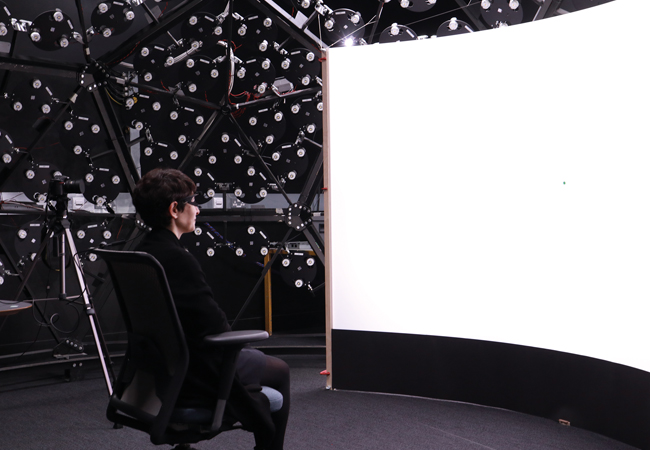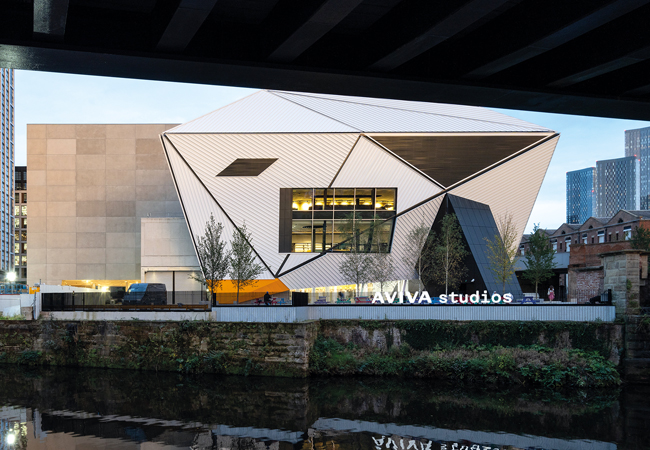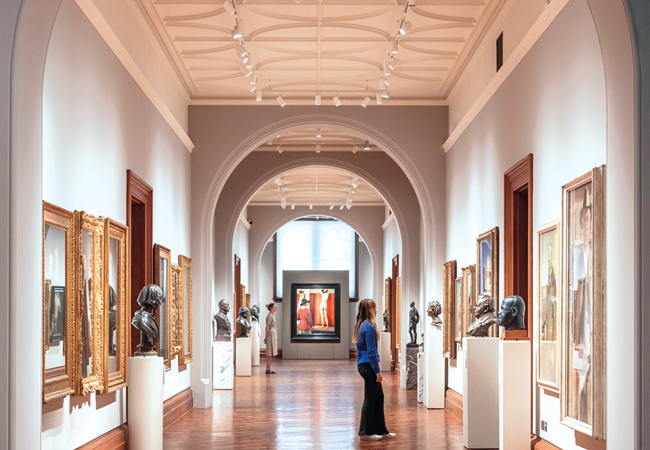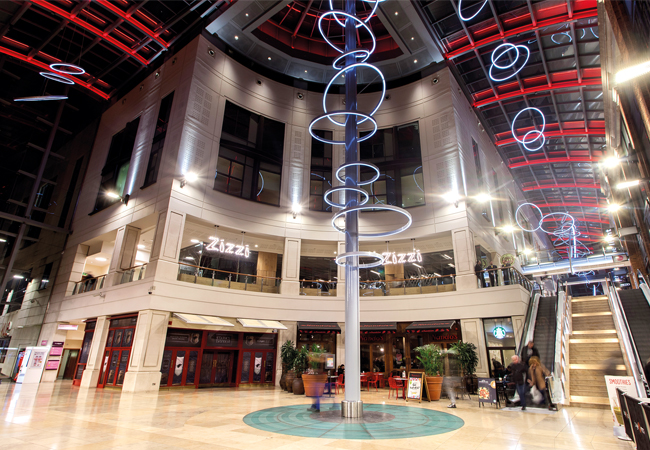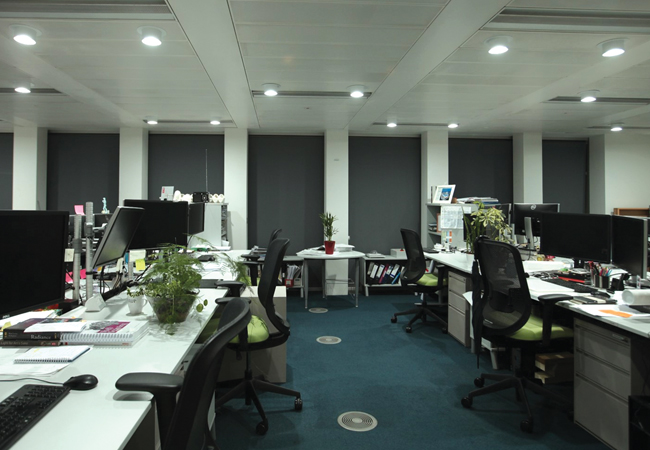
The section of the Arup London office with Ledmotive’s spectrally tunable lighting system installed
For millennia, the modern human visual system evolved solely under exposure to natural daylight. This is a mixture of light from the sun and sky, containing energy at all wavelengths in the visible spectrum.
Since the invention of the candle, at least 2,500 years ago, humans have become more reliant on artificial lighting technologies – and increasingly so in the past century, since the development of electric light. This has led to more activities being performed indoors, significantly shortening the daily exposure to natural light.
In the design of illumination for indoor spaces, only well-established visual effects of light – such as illuminance, glare, chromaticity or correlated colour temperature (CCT), and colour rendering indices (CRI or TM-30, for instance) – have traditionally been considered. However, there is now a new drive to characterise lighting in terms of its non-visual effects on human behaviour.
This follows the recent discovery, in the eye, of the intrinsically photosensitive retinal ganglion cells (ipRGCs) as the origin of the non-visual pathway that entrains biological rhythms to the light/dark circadian cycle.
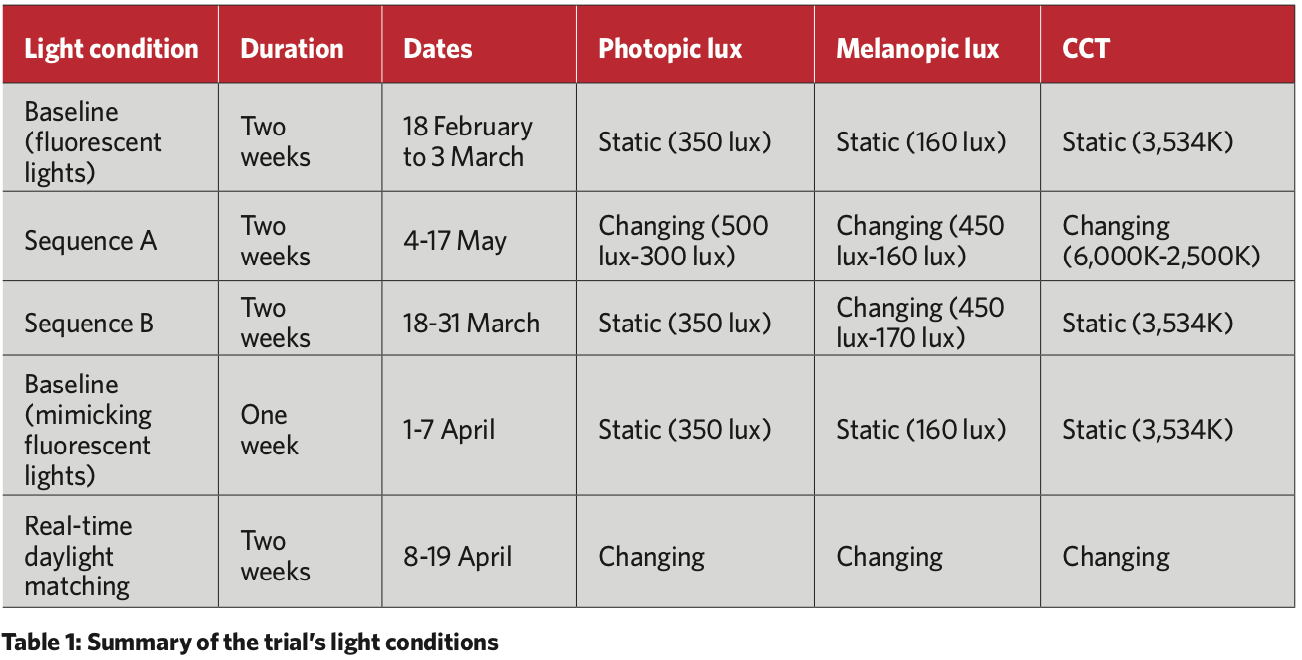
Non-visual pathway
This non-visual pathway is responsible not only for regulating the circadian rhythms of body temperature, melatonin secretion and the overall sleep/wake cycle, but also for modulating cognitive function, attention and mood. Although it has long been known that the entraining light signal emanated from the retina, it was not until the discovery of the ipRGCs – and the characterisation of the melanopsin photopigment they contain – that the importance of spectral variations in light for eliciting non-visual effects was recognised fully.
The spectral sensitivity of melanopsin peaks at 480nm, midway between the short- and middle-wavelength cones, but because of the relative broadband tuning of photopigments, it overlaps with that of all four classical photoreceptors. Modulation of the short-wavelength (‘blue’) content of light has been shown to affect various physiological measures, such as melatonin suppression, alertness, thermoregulation, heart rate, cognitive performance, and electroencephalographic dynamics.

The effectiveness of a given light spectrum in activating the non-visual pathway may be quantified by its melanopic lux, the spectral irradiance weighted by the melanopsin spectral sensitivity function and integrated over wavelength, or by functions of the same. So, melanopic lux is an appropriate characteristic of illumination to consider in addition to visual factors such as photopic lux or CCT.
Tunable lighting
Currently, the most common artificial light sources are fluorescent lights and white LEDs, which are all static sources with spectra very different from natural daylight. The recent invention of narrow-band LEDs enables the development of spectrally tunable light sources that can generate illuminations with arbitrary spectral shapes, and so mimic daylight spectral patterns or create tailored dynamic spectral sequences according to end-user needs.
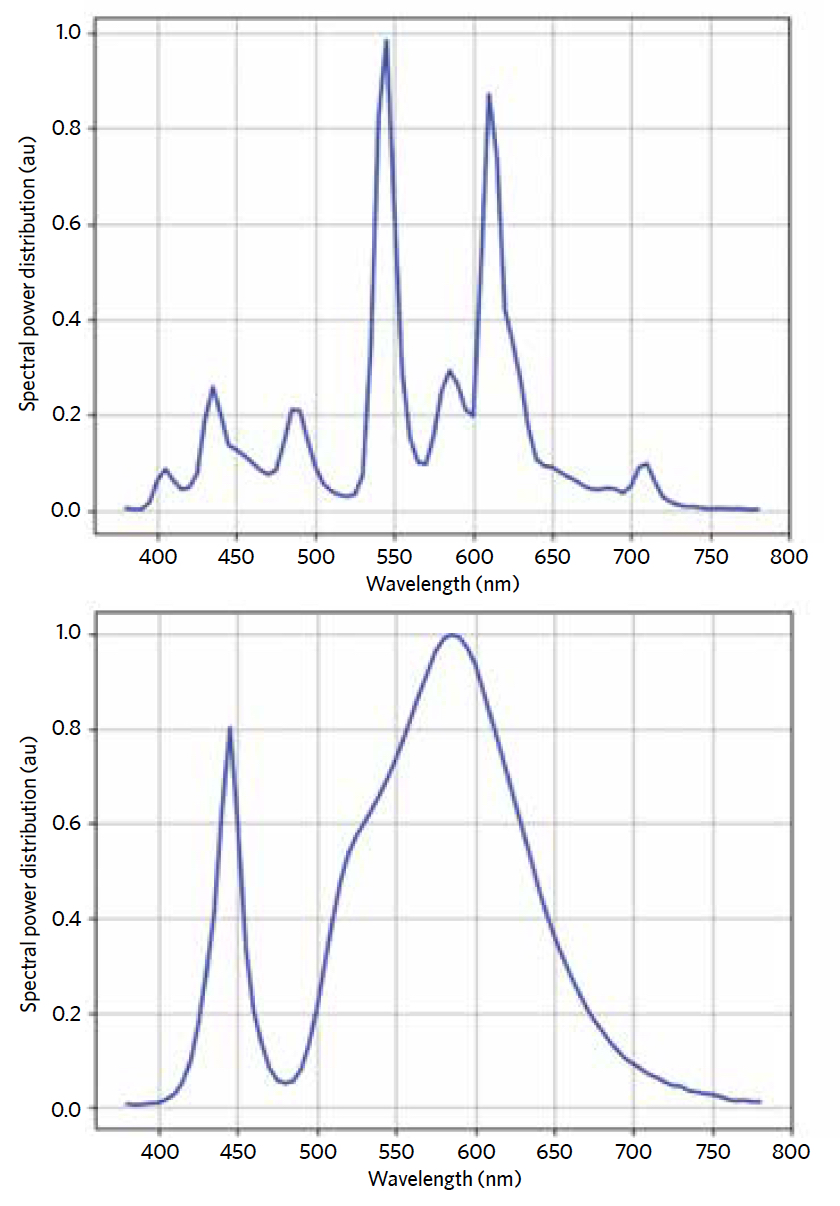
Figure 2: Baselines – the SPD of the real fluorescent lights (top) and the SPD of the spectrally tunable light engine (bottom). Both measured spectra have the same CCT of 3,550K, the same photopic lux of 350 lux, and the same melanopic lux of 160 lux at desk level
Previous studies have compared the performance of individual subjects under different artificial lighting conditions. Such studies, though, have used only two types of white light, both fixed in time – cool, blue-enriched fluorescent light and warm fluorescent light – and have not exploited the novel spectral flexibility offered by multichannel LED light sources.
In this study, and for the first time in a real office setting (Arup’s London headquarters), the behavioural effects of a dynamic, spectrally tunable lighting system were investigated. The study included assessments of alertness, mood, sleep quality, performance and mental effort of the occupants, plus other responses to different dynamic illumination conditions, in a nine-week intervention.
The aim was to assess whether sculpting different spectral power distributions (SPDs) of light may bring measurable benefits in terms of wellbeing and productivity in an indoor workplace. More generally, we wanted to understand better the behavioural effects of different lighting conditions in indoor environments and raise awareness of the importance of a circadian lighting approach.
The area selected for the study, shown in the image above, measured around 160m2 and involved the working desks of 24 people. A set of 36 downlight luminaires containing Ledmotive (model VEGA07) tunable light engines were installed into ceiling panels, alongside the pre-existing fixed fluorescent light tubes. These comprised 48 commercial monochromatic LEDs arranged in seven channels, each with a distinct peak wavelength, spread over the visible spectrum. External light sources were blocked by covering the windows along one wall completely.
Study time
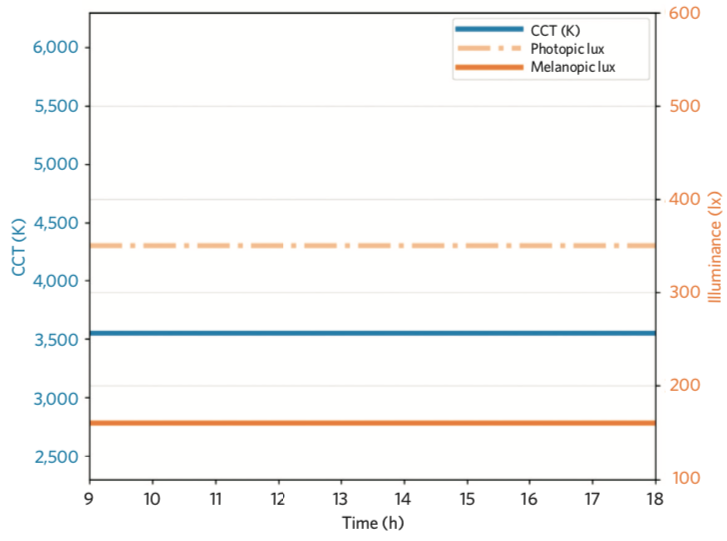
Figure 3: In an office setting with only fluorescent sources, light indicators – such as CCT, photopic lux or melanopic lux – coming from the light fixtures remain static during the whole working day
For the first two weeks, the study was conducted solely under the pre-existing traditional fluorescent lights, to provide a baseline. The second two weeks were spent under spectrally tunable light sequence A, and the third two weeks under spectrally tunable light sequence B. During the fourth one-week period, the spectrally tunable lights mimicked the baseline fluorescent output, and in the final two weeks, they mimicked real-time daylight patterns.
The regular fluorescent sources – the light conditions set for the first two weeks – have a familiar spiky spectrum (see Figure 2, top graph), totally different from natural daylight. The office’s fluorescent sources had a CCT of 3,550K, and typical values of photopic lux at the desktop were around 350 lux. The melanopic lux for this light was about 160 lux at the desktop. During the seventh week, when mimicking fluorescent lights with the spectrally tunable light source (see Figure 2, bottom graph), the light generated had the same parameters: CCT of 3,550K, photopic lux of 350 lux and melanopic lux of 160 lux at the desk level.
Light sequence A had temporally changing melanopic lux, photopic lux and CCT during the day, with: melanopic lux falling from a high of 450 in the morning to a low of 160 in the evening; photopic lux falling from 500 in the morning to 300 in the evening; and the CCT changing from cool (6,000K) to warm (2,500K) over the same interval. Light sequence B matched light sequence A in terms of its changing melanopic lux, but kept constant photopic lux and CCT at levels matching the baseline fixed fluorescent lights.

Figure 4: Sequence A (left) was designed to have changing CCT, photopic lux and melanopic lux during the day. In situ measured spectra from sequence A SPD (right), varying from 9am (blue) to 6pm (red)
High melanopic lux in the morning is thought to lead to better attention and higher arousal, while low melanopic lux in the evening is suitable for relaxing and for better sleep at night. In this experiment, light sequence A was designed to change in CCT from cool in the morning to warm in the afternoon, and with photopic and melanopic lux values changing from high in the morning to low in the afternoon (see Figure 4).
Sequence B was designed with the same visual parameters as baseline (same CCT and photopic lux) but with changing melanopic lux values during the day (see Figure 5). By comparing sequence B with baseline, the experiment compared the effects of changing melanopic lux alone, with the other parameters remaining the same. With sequence A, we were able to test not only the melanopic lux effect, but also the effect of concomitant changes in CCT, as the visual comfort and overall experience that the light fixtures evoke is important for wellbeing, too.

Figure 5: Sequence B (left) was designed to have the same static CCT and photopic lux as baseline throughout the day, but with changing melanopic lux. In situ measured spectra from Sequence B SPD (right), varying from 9am (blue) to 6pm (red)
Measuring effects
Subjective and objective measurements were taken throughout the study. As part of the subjective assessment, participants were asked to complete web-based questionnaires at four time points each weekday (on waking, mid-morning, mid-afternoon and before going to sleep) and at two time points (waking and before sleep) on each day of the weekend and holidays. As an objective measure, they were asked to wear, 24/7, a smart watch that keeps track of body temperature, illuminance exposure and activity levels. They were also asked to complete a five-minute visual attention task at two timepoints each weekday. This was a continuous performance task that assessed sustained attention and response time, implemented via a web-based JavaScript application.
During the trial’s final two weeks, a calibrated spectrometer was installed in the building’s roof to measure daylight spectra every few seconds. Connected to a Raspberry Pi, the spectrometer sent the spectral information to the lighting system control unit, which very rapidly found the channel weights that gave the best spectral fitting to the target SPD. Any change in SPD or illuminance in the outdoor environment was smoothly translated inside the office.
The final results need further analysis and elaboration, but the following are the initial conclusions drawn from the study:
- Those taking part in the study preferred the variability and tunability of lights, especially in areas with minimal daylighting
- They also preferred the variability in electric lighting that reflected real-time daylight conditions effected by a link to outside (in this case, a roof-mounted spectrometer connected to the lighting control system)
- Participants also did not perceive a higher CCT of around 5,500K as being too cold or unpleasant. This is an aspect of LED source specification that can be explored on future projects. Cooler colour temperatures have the benefit of imparting marginally higher lumens/W, boosting the energy-savings aspect
- Higher CCTs also lead to a higher melanopic ratio, which might be beneficial for projects targeting the circadian lighting feature in the Well Building Standard criteria.
About the author
Rohit Manudhane is an architect, daylighting and lighting designer at Arup. Other project members included: Anya Hurlbert, professor of visual neuroscience at Newcastle University; Florence Lam, director, global lighting design, at Arup; Aleix Llenas, researcher at the Catalonia Institute for Energy Research; plus manufacturers Castan Architectural Lighting and Ledmotive
The original research paper can be here.



